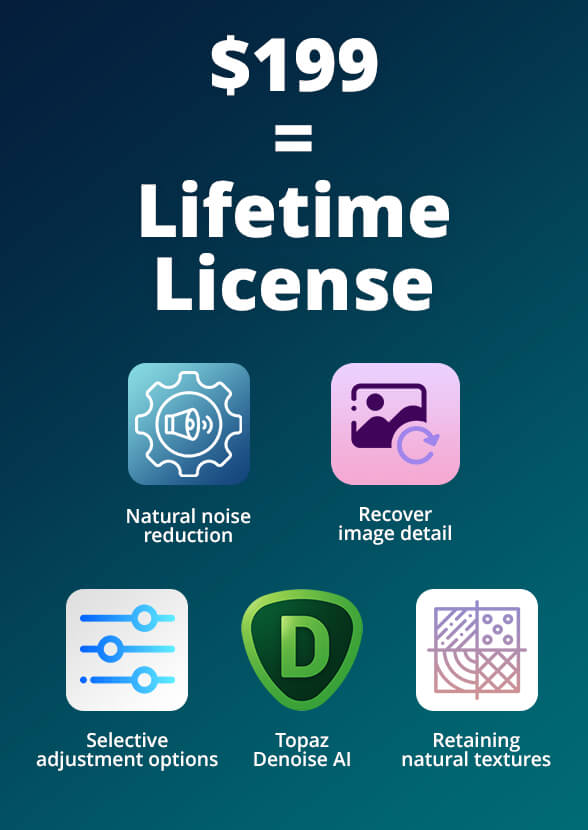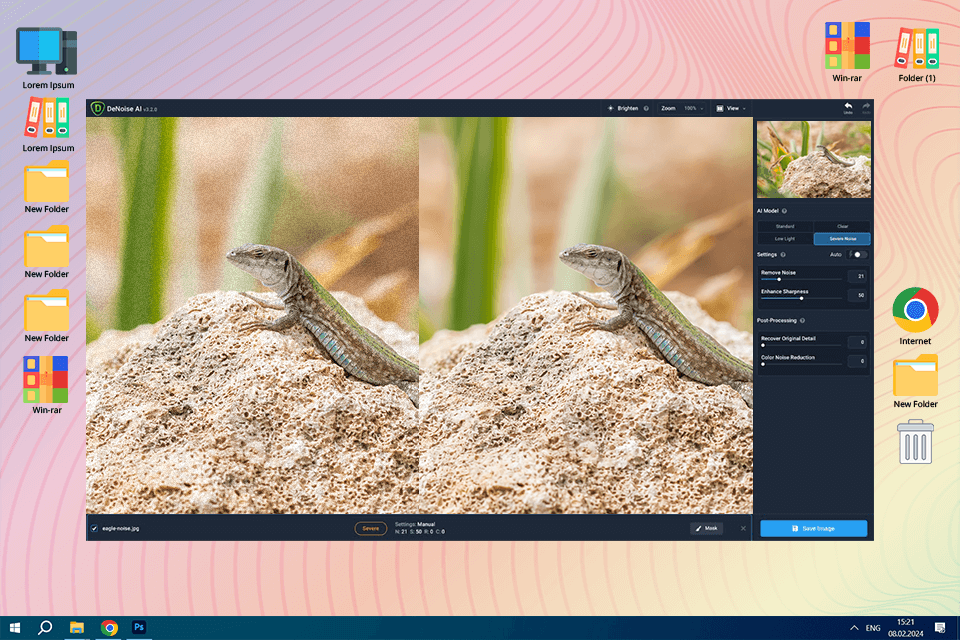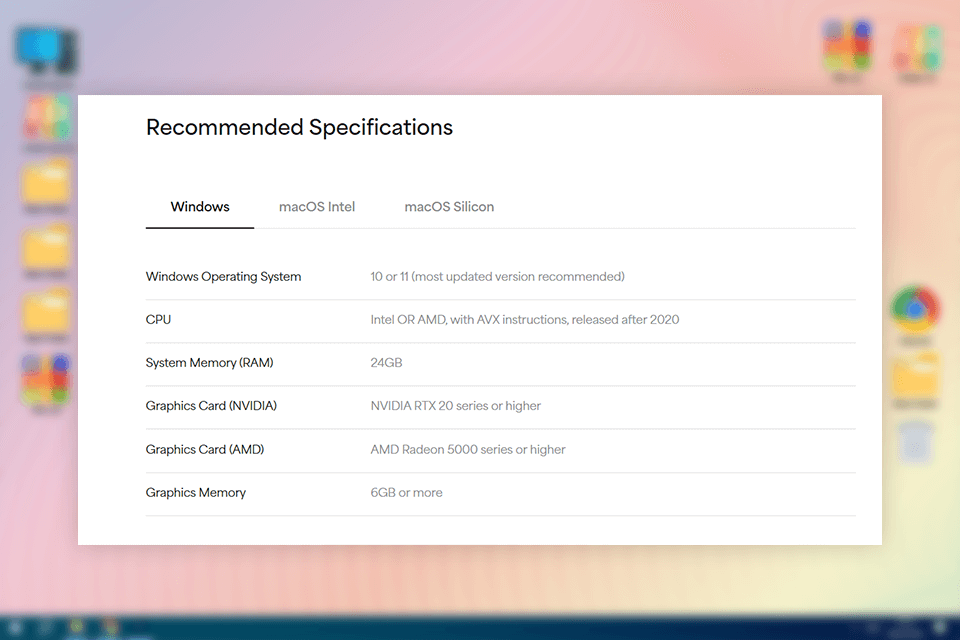I’m a professional photo retoucher and I'm always looking for new tools to improve my work. When I got early access to the latest Topaz DeNoise AI, I was eager to test its capabilities. I used the program to edit a collection of noise wildlife photos taken by my colleague Tanya. I liked both the working process and the results. This new version copes well with noise removal without making the photos look blurry or flat.

Previously, I used Topaz DeNoise AI 2021 to edit my images. It satisfied most of my needs, but still had some limitations. It was slow when working with RAW images, and it didn't do a great job with photos that were really noisy.
I’m very impressed with the new version of this noise reduction software. Now, photo editing takes less time and all my processed pictures look amazing.
|
File name:
|
topaz_denoise_ai.exe (download)
|
|
File size:
|
112MB
|
|
File name:
|
topaz_denoise_ai_mac.dmg (download)
|
|
File size:
|
104MB
|
|
File name:
|
topaz_denoise_ai_mac.dmg (download)
|
|
File size:
|
109MB
|
|
File name:
|
topaz_denoise_ai_win_11.dmg (download)
|
|
File size:
|
113MB
|
|
File name:
|
topaz_denoise_ai_win_10.dmg (download)
|
|
File size:
|
101MB
|
✔️ RAW photo editing. Topaz software is a wonderful program if you need to improve RAW images. It does an amazing job of preserving color accuracy and tonal range. I've used it to edit photos of birds against a sunrise backdrop. The results were fantastic. The colors were incredibly rich and natural, even after I fixed noise.

✔️ Selective adjustment options. The Topaz Denoise AI changed limitations in noise reduction. Now, you can target specific areas in a photo and fix them without affecting the rest of the shot. I recently edited a photo of a deer in the woods. My coworker Tanya took it in dense foliage and I needed to reduce the noise in the background without losing any of the detail in the deer's coat. I’m glad this version was up to the task.
✔️ Preserves natural textures. Topaz DeNoise AI maintains a balance between removing noise and preserving details. When I used it on a macro shot of a squirrel's whiskers, I was impressed by how it eliminated the noise without making the whiskers look soft or blurry. The photo ended up looking both professional and realistic.
✔️ Batch photo processing. I recently edited a huge collection of over 50 images for Tanya, applying noise reduction to all of them. Fortunately, this batch photo editor coped with the task perfectly. I received consistent results across the entire set. It's a wonderful possibility when you're working on a big project and need to get things done quickly.
❌ Requires a powerful computer. I was very pleased with the results I got from Topaz DeNoise AI, but I quickly realized it has some pretty high system requirements. My older laptop struggled to handle the image processing, especially with large RAW files. This is displeasing for photographers like me who don't have the latest and greatest computers but need to use a RAW photo editor.

❌ Takes time to master. Topaz is a powerful tool, but it can scare off total novices. The basic functions are easy to grasp, but when it comes to fine-tuning noise reduction, you need to spend some time to achieve the desired result. I fully understand the intricacies of the process when editing photos of birds against a noisy background.
❌ Price. Topaz DeNoise AI is a powerful tool that can greatly enhance your photos, but it's not cheap. Tetiana pointed out that as an amateur photographer, she's unsure if she needs all the features that this software offers, and the cost is too high for her.
Topaz AI improve creative workflows for many users with its powerful AI-driven tools. Still, photographers who are watching their spending may not be willing to pay such a sum for this program. Fortunately, there are several free options out there that are worth exploring. Of course, none of these free tools can compete with Topaz's extensive capabilities, but they can still give you pretty good results if you know how to use them.
Darktable is a free, open-source photo editor with some noise reduction features. It's a good choice if you're on a budget and want something similar to Lightroom. Still, don’t expect too much from its noise reduction functionality. When you try to reduce noise in detailed, low-light photos, Darktable tends to over-smooth things, causing sharpness issues.
You could also try GIMP with a noise reduction plugin like “Wavelet Denoise”. GIMP is a powerful image editor, but its noise reduction process is a bit more complicated. To get the same quality results as Topaz DeNoise AI, you need to spend more time adjusting the settings manually. This can be annoying if you want something quick and easy.
RawTherapee is a modern RAW image editor that includes noise reduction features. It can handle noise in pictures, but when you have very noisy images, it may deliver poor results. Processed photos will appear inconsistent, excessively soft, or too noisy. Topaz, on the other hand, is more efficient in preserving details while reducing noise.
Dfine 2, from the older Nik collection, is a simple noise reduction tool. However, it's not as powerful as newer options. When you use it on high-resolution photos, you may notice that it leaves some artifacts or makes the image look less sharp, especially compared to AI-powered tools like Topaz.
All in all, these free options can be useful, but none of them can fully replace Topaz DeNoise AI. This professional program is worth every penny you spend on it.